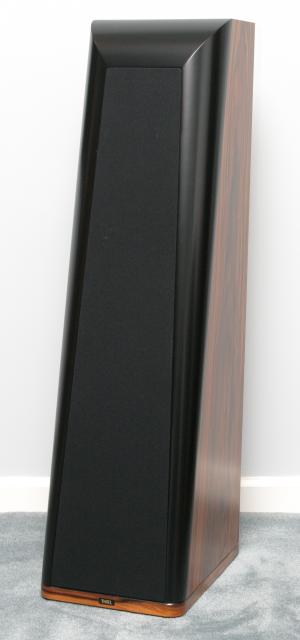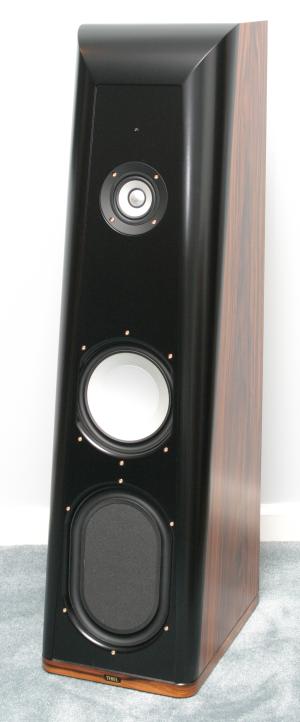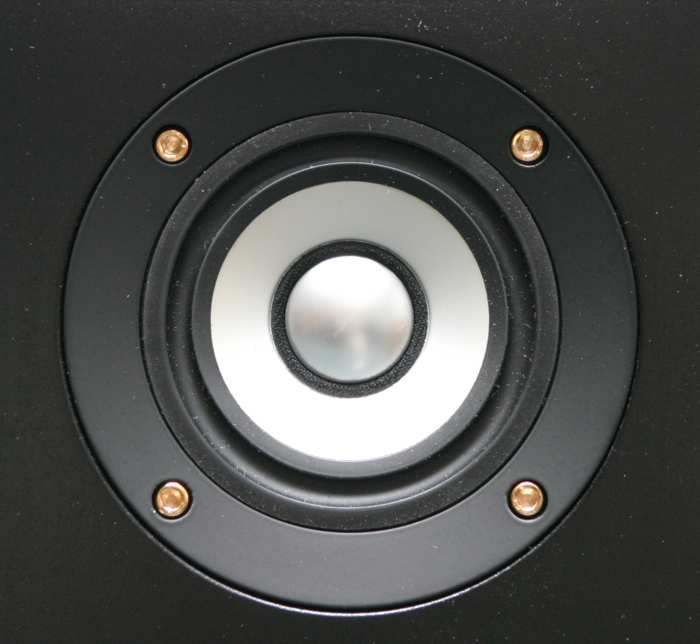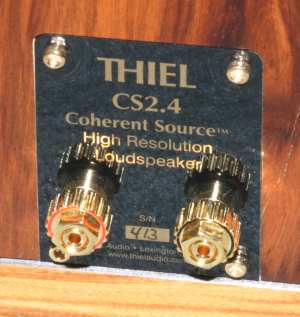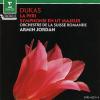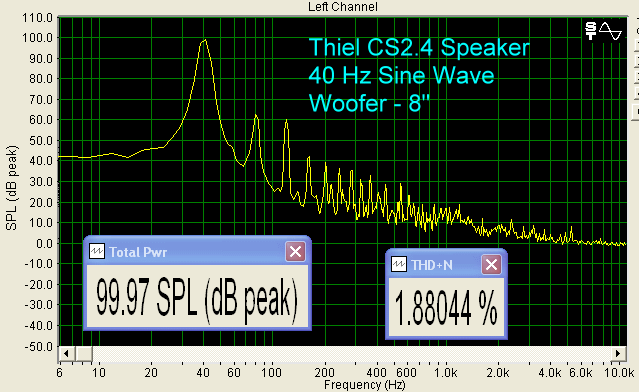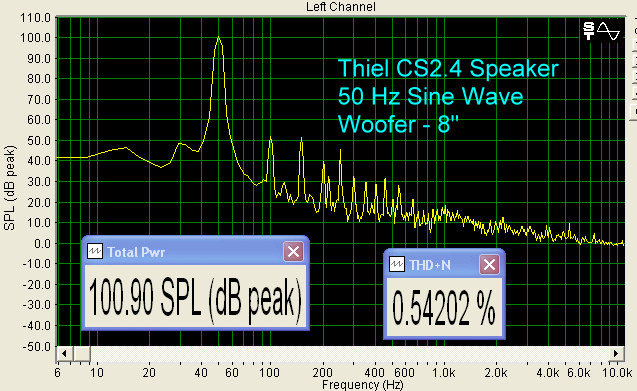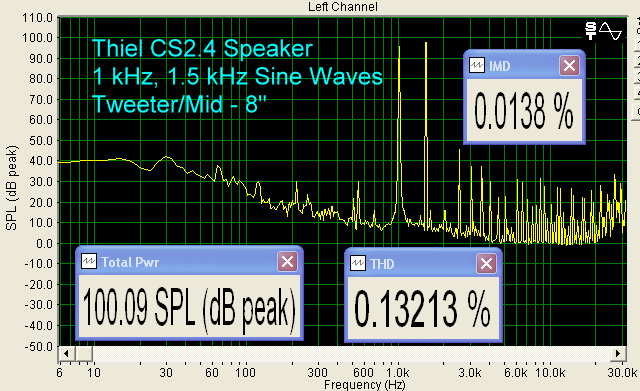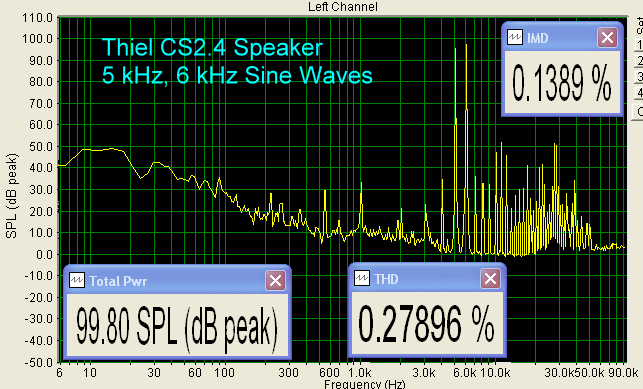|
|||||||||||||||
|
Introduction Thiel Audio is a medium sized speaker manufacturer, co-owned by Jim Thiel, who is Chief Engineer and CFO, and Kathy Gornik, who is President and Marketing Director. Located in Lexington, Kentucky, the company is 25 years old and has garnered many awards for their various models. The Design This is our first review of Thiel speakers, with the newly released model CS2.4. They are a floor-standing speaker, with a tweeter and midrange driver that share the same voice coil.
This results in a coincident sound for the highs and mids, meaning that they are coming from the same spot on the enclosure. It is a technology developed in 1997 for the CS2.3s, and has also been used in their PCS and MCS1 speakers. The version in the CS2.4 is improved over the one in the CS2.3. The photo below shows a close-up of the tweeter/mid driver. The center 1" is the tweeter, with a small black rubber surround, then the midrange driver, and its surround. The crossover between the midrange and tweeter is mechanical rather than having capacitors and inductors in the signal path.
The woofer is 8" in diameter, and below this is a 7 1/2" x 11" passive radiator. All the drivers use metal cones. Electrical crossover between the woofer and tweeter/mid is first order, at 1 kHz. The enclosure is finished on all sides (including the insides) with wood veneer, having several choices, including my favorite, natural cherry. The grilles are metal frames that attach by use of small magnets embedded in the enclosure front metal plate. The speaker binding posts are of very high quality, are extremely heavy, and gold plated. They are not bi-wirable.
If you notice from the photos, the speakers are angled back. This aligns the voice coils of the drivers in a vertical plane, since the woofer voice coil would otherwise be farther back than the voice coil of the tweeter if the speaker were straight up and down. As a result, the sound from the tweeter and woofer reach your ears at the same time. Why doesn't everyone do this? Because it is more expensive to build an enclosure on an angle. The front edges of the enclosure are beveled. This reduces air turbulence from the drivers, and reduces coloration of the sound. Again, it's an expensive piece of carpentry to do this. The CS2.4s are 4 Ohms nominal and medium sensitivity, so a high quality amplifier must be used to drive them. The Sound I tested the CS2.4s with a McCormack CD Transport and DAC, Balanced Audio Technology VK-5i Preamplifier, Balanced Audio Technology VK-500 Power Amplifier, McIntosh MC-602 Power Amplifier, and Nordost Cables. I toed the speakers in at about 150 towards my listening position. It took several days of constant music playing to break these speakers in, but the major change occurred in the first couple of hours. They started out with a slightly harsh upper end and thin bass, but they soon opened up. I broke them in with some pretty heavy music, played at medium volume, with about 30 - 60 watts of power. I have to say right off the bat that the CS2.4s are some of the best speakers I have ever heard. The soundstage was very tall, as if the whole wall were alive, almost like listening to my planar speakers. However, planar speakers sometimes tend to lose a bit of detail because the sound is coming from such a large surface. The CS2.4s, on the other hand, although having a large soundstage, still maintained a magnificent amount of detail, probably in part because of the coincident tweeter and midrange drivers. The bass was tight, never boomy or chesty, the mids were clean and never overly sibilant, and the upper frequencies were crisp without being edgy. One of my favorite CDs of all time is the Telarc recording of Copland's Fanfare for the Common Man. It has high pitched trumpets and thundering bass. It is also a good test for any audio system. The Thiel's handled this piece in stride, without breaking up at all. The bass was tight and clean, and the huge bass drum used in this recording is a stress test to end all tests. (You can click on any of the album cover art photos to see more details, including catalog numbers.) Tony Bennett, Mary Chapin Carpenter, and Natalie Cole stand close to their microphones, and their voices are so clear, that any chestiness or sibilance produced by speakers becomes very apparent. The CS2.4s put these terrific performers into my room for a private concert, with no hint of such artifacts. Dukas' La Peri on Erato is another great recording that does not use dynamic compression. The brass, as presented by the CS2.4s, raised the hair on the back of my neck, as it should, but will not if the speakers are incapable. For violins, Tchaikovsky's Serenade for Strings is a fine test. The CS2.4s gave me a clear view of all the string sections here. No mushiness or bloated midrange that would be suggestive of high THD. I found I needed about 30 watts for the listening level that I like, with peaks from 60 watts to about 120 watts (as indicated on the McIntosh MC-602 level meters that measure voltage and current to display the watts). On the Bench Distortion at 40 Hz and 100 dB (microphone was 8" away from respective drivers for distortion tests), showed excellent results, with less than 2% THD.
At 50 Hz and 100 Hz, distortion was less than 1%. This is very good performance.
At 1 kHz and 100 dB, distortion is very low.
IMD measurements showed very low distortion using a combination of 1 kHz and 1.5 kHz, or 5 kHz and 6 kHz.
With a 10 kHz sine wave input, distortion again, is very low.
The frequency response is quite flat, with some dips between 100 Hz and 400 Hz. There is also a peak at 19 kHz. The impulse response shows the peaks for the drivers are very close together, indicating that the time alignment design of this speaker is working.
Impedance/Phase results show that the impedance stays down around 4 Ohms at 100 Hz and above, while the electrical phase is within + 300 to - 600 throughout the audible frequency range. Don't try and drive these speakers with a mass market receiver. At least 200 watts RMS per channel into 8 Ohms, with a rating into 4 Ohms, will be a good choice.
Conclusions Thiel's new CS2.4 speakers are superb. They have no noticeable tonality aberrations, i.e., they sound neutral throughout their range, they have a big soundstage, and have marvelous detail. They will undoubtedly be one of the great speaker introductions of 2003. At their price, I have never heard anything better, and many are not nearly as good. They are beautifully constructed and pleasing to the eye. Recommending the CS2.4s is one of the easiest jobs I have had to date.
- John E. Johnson, Jr. -
|
|||||||||||||||

